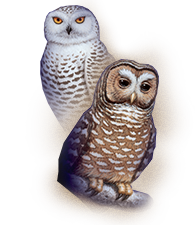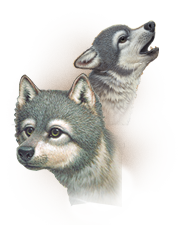
 |
 |
 |
 |
 |



In the beginning of The Capture, baby Soren finds himself grounded, pushed out of the nest by his evil older brother.
In nature, owlets often find themselves grounded in the process of testing their wings. Many young birds lose their footing during these first explorations and fall to the ground. A grounded chick may look lost and vulnerable, but chances are, its parents know exactly where it is, and will continue to feed and care for it. Also, many young birds are quite capable of climbing back into their tree using their beaks and talons.
If you find a grounded owlet, don't panic. If the chick is not obviously injured, or in immediate danger from vehicles, people or predators, the best thing to do is just walk away quietly and let nature take its course.
The word Owl comes from the Old English word ule, meaning, "to howl", referring to the sound an owl makes.
It's believed that there are about 140 different kinds of owls living around the world.
There are two different types of owls. Owls with a round face are Strigidae (STRI-juh-dee) Owls. Owls with heart shaped faces are Tytonidae (Tie-TON-ih-dee) Owls.
The smallest owl is the elf owl. It is 5 inches (12.5 cm) long.
The largest owl is the great gray owl. It is 33 inches (82.5 cm) long.
The male owl is usually smaller than the female.
Owls have very flexible necks that allow them to turn almost all the way around. Owls can even turn their heads upside down.
Owls usually swallow their food whole, head first. When an animal is too big to swallow, the owl shreds it with its beak.
Owls cannot chew or grind their food. They cough up what they can't digest in pellets. The pellets usually contain fur and bones from their prey.
Large owls live longer than small owls.
Owls are raptors. Raptors are birds of prey, meaning they are hunters that eat meat.
Most owls are nocturnal (knock-TURN-ul) and hunt at night.
An Owls eyes are about the size of a human eyes. Owls can change the focus of their eyes and see great distances. At night the pupils of owls eyes get bigger. This allows more light to enter their eyes, giving them incredibly good vision at night.
In many owls one ear is higher than the other.
In nature, owlets often find themselves grounded in the process of testing their wings. Many young birds lose their footing during these first explorations and fall to the ground. A grounded chick may look lost and vulnerable, but chances are, its parents know exactly where it is, and will continue to feed and care for it. Also, many young birds are quite capable of climbing back into their tree using their beaks and talons.
If you find a grounded owlet, don't panic. If the chick is not obviously injured, or in immediate danger from vehicles, people or predators, the best thing to do is just walk away quietly and let nature take its course.
The word Owl comes from the Old English word ule, meaning, "to howl", referring to the sound an owl makes.
It's believed that there are about 140 different kinds of owls living around the world.
There are two different types of owls. Owls with a round face are Strigidae (STRI-juh-dee) Owls. Owls with heart shaped faces are Tytonidae (Tie-TON-ih-dee) Owls.
The smallest owl is the elf owl. It is 5 inches (12.5 cm) long.
The largest owl is the great gray owl. It is 33 inches (82.5 cm) long.
The male owl is usually smaller than the female.
Owls have very flexible necks that allow them to turn almost all the way around. Owls can even turn their heads upside down.
Owls usually swallow their food whole, head first. When an animal is too big to swallow, the owl shreds it with its beak.
Owls cannot chew or grind their food. They cough up what they can't digest in pellets. The pellets usually contain fur and bones from their prey.
Large owls live longer than small owls.
Owls are raptors. Raptors are birds of prey, meaning they are hunters that eat meat.
Most owls are nocturnal (knock-TURN-ul) and hunt at night.
An Owls eyes are about the size of a human eyes. Owls can change the focus of their eyes and see great distances. At night the pupils of owls eyes get bigger. This allows more light to enter their eyes, giving them incredibly good vision at night.
In many owls one ear is higher than the other.



Horses lie down only about 45 minutes a day
Horses sleep longer in the summer than in the winter
A horse's teeth can be used to estimate its age
Horses younger than 4 years can concentrate for a maximum of 10-15 minutes
Horses gallop at around 27 mph
Because horse's eyes are on the side of their head they are capable of seeing nearly 360 degrees at one time.
Horses can sleep both lying down and standing up
Horses' hooves grow approximately 0.25 in a month, and take nearly a year to grow from the coronet band to the ground.
Horses can run shortly after birth.
A male horse is called a stallion.
Horses have around 205 bones in their skeleton.
You measure a horse's height in hands. Each hand equals four inches. If you say a horse is 16.2 hands high, the 2 stands for 2 fingers.
Horses and ponies feel safer when they are in a herd.
Any marking on a horse's forehead is called a star, even if it is not shaped like a star.
A hoof is like a fingernail. It is always growing and needs to be clipped so that it won't be uncomfortable for the horse
Horses sleep longer in the summer than in the winter
A horse's teeth can be used to estimate its age
Horses younger than 4 years can concentrate for a maximum of 10-15 minutes
Horses gallop at around 27 mph
Because horse's eyes are on the side of their head they are capable of seeing nearly 360 degrees at one time.
Horses can sleep both lying down and standing up
Horses' hooves grow approximately 0.25 in a month, and take nearly a year to grow from the coronet band to the ground.
Horses can run shortly after birth.
A male horse is called a stallion.
Horses have around 205 bones in their skeleton.
You measure a horse's height in hands. Each hand equals four inches. If you say a horse is 16.2 hands high, the 2 stands for 2 fingers.
Horses and ponies feel safer when they are in a herd.
Any marking on a horse's forehead is called a star, even if it is not shaped like a star.
A hoof is like a fingernail. It is always growing and needs to be clipped so that it won't be uncomfortable for the horse



Wolves do not make good guard dogs because they are naturally afraid of the unfamiliar and will hide from visitors rather than bark at them
Wolves run on their toes, which helps them to stop and turn quickly and to prevent their paw pads from wearing down
Wolves have about 200 million scent cells. Humans have only about 5 million. Wolves can smell other animals more than one mile away
A wolf pup's eyes are blue at birth. Their eyes turn yellow by the time they are eight months old
The wolf is the largest in the wild canine family
Wolves have rounded ears
The wolf is an ultimate predator at the top of the food chain
In chases, the wolf can achieve estimated speeds of between 28 and 40 miles per hour for up to 20 minutes
Wolves spend hours each day roaming; some packs cover a distance of about 100 miles or more in one day.
Wolf pups are born deaf and blind while weighing around 0.5 kg (1 lb.). It takes about 8 months before they are old enough to actively join in wolf pack hunts.
Unlike other animals, wolves have a variety of distinctive facial expressions they use to communicate and maintain pack unity.
Wolves howl to contact separated members of their group, to rally the group before hunting, or to warn rival wolf packs to keep away. Lone wolves will howl to attract mates or just because they are alone. Each wolf howls for only about five seconds, but howls can seem much longer when the entire pack joins in
Wolves evolved from an ancient animal called Mesocyon, which lived approximately 35 million years ago. It was a small dog-like creature with short legs and a long body.
A hungry wolf can eat 20 pounds of meat in a single meal, which is like a human eating one hundred hamburgers
The wolf uses its hair to communicate anger, dominance and aggression
All members of a wolf pack take part in caring for the young
The wolf's front teeth are sharp and pointed and adapted to puncturing, slashing, and clinging
Wolves run on their toes, which helps them to stop and turn quickly and to prevent their paw pads from wearing down
Wolves have about 200 million scent cells. Humans have only about 5 million. Wolves can smell other animals more than one mile away
A wolf pup's eyes are blue at birth. Their eyes turn yellow by the time they are eight months old
The wolf is the largest in the wild canine family
Wolves have rounded ears
The wolf is an ultimate predator at the top of the food chain
In chases, the wolf can achieve estimated speeds of between 28 and 40 miles per hour for up to 20 minutes
Wolves spend hours each day roaming; some packs cover a distance of about 100 miles or more in one day.
Wolf pups are born deaf and blind while weighing around 0.5 kg (1 lb.). It takes about 8 months before they are old enough to actively join in wolf pack hunts.
Unlike other animals, wolves have a variety of distinctive facial expressions they use to communicate and maintain pack unity.
Wolves howl to contact separated members of their group, to rally the group before hunting, or to warn rival wolf packs to keep away. Lone wolves will howl to attract mates or just because they are alone. Each wolf howls for only about five seconds, but howls can seem much longer when the entire pack joins in
Wolves evolved from an ancient animal called Mesocyon, which lived approximately 35 million years ago. It was a small dog-like creature with short legs and a long body.
A hungry wolf can eat 20 pounds of meat in a single meal, which is like a human eating one hundred hamburgers
The wolf uses its hair to communicate anger, dominance and aggression
All members of a wolf pack take part in caring for the young
The wolf's front teeth are sharp and pointed and adapted to puncturing, slashing, and clinging
